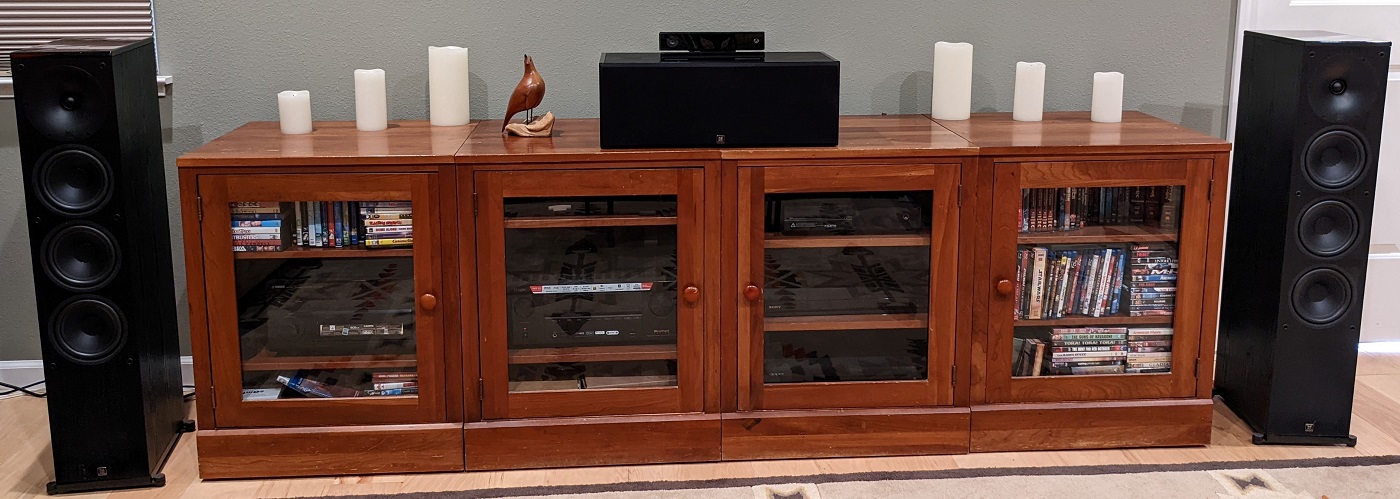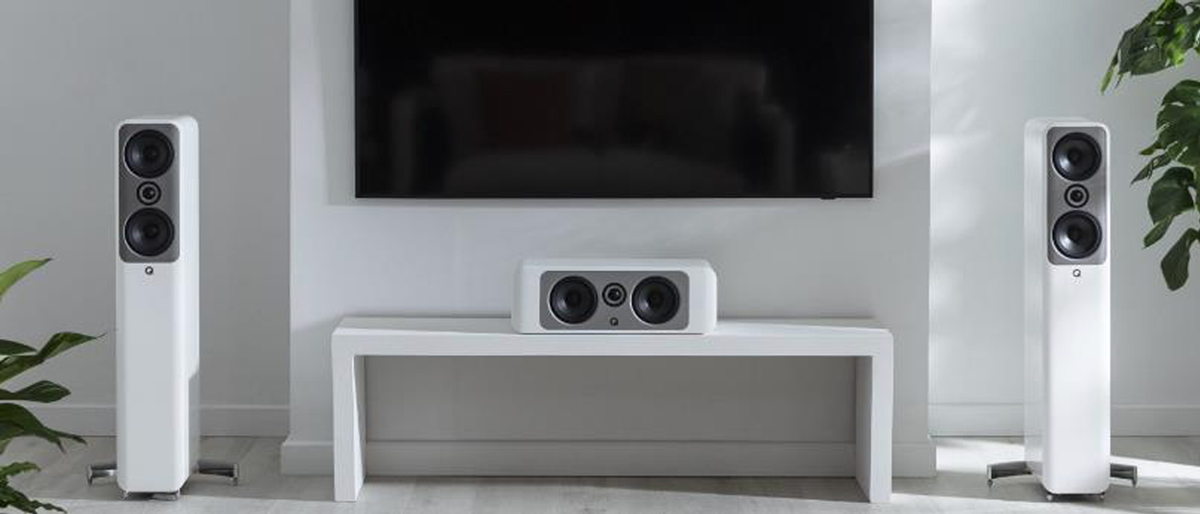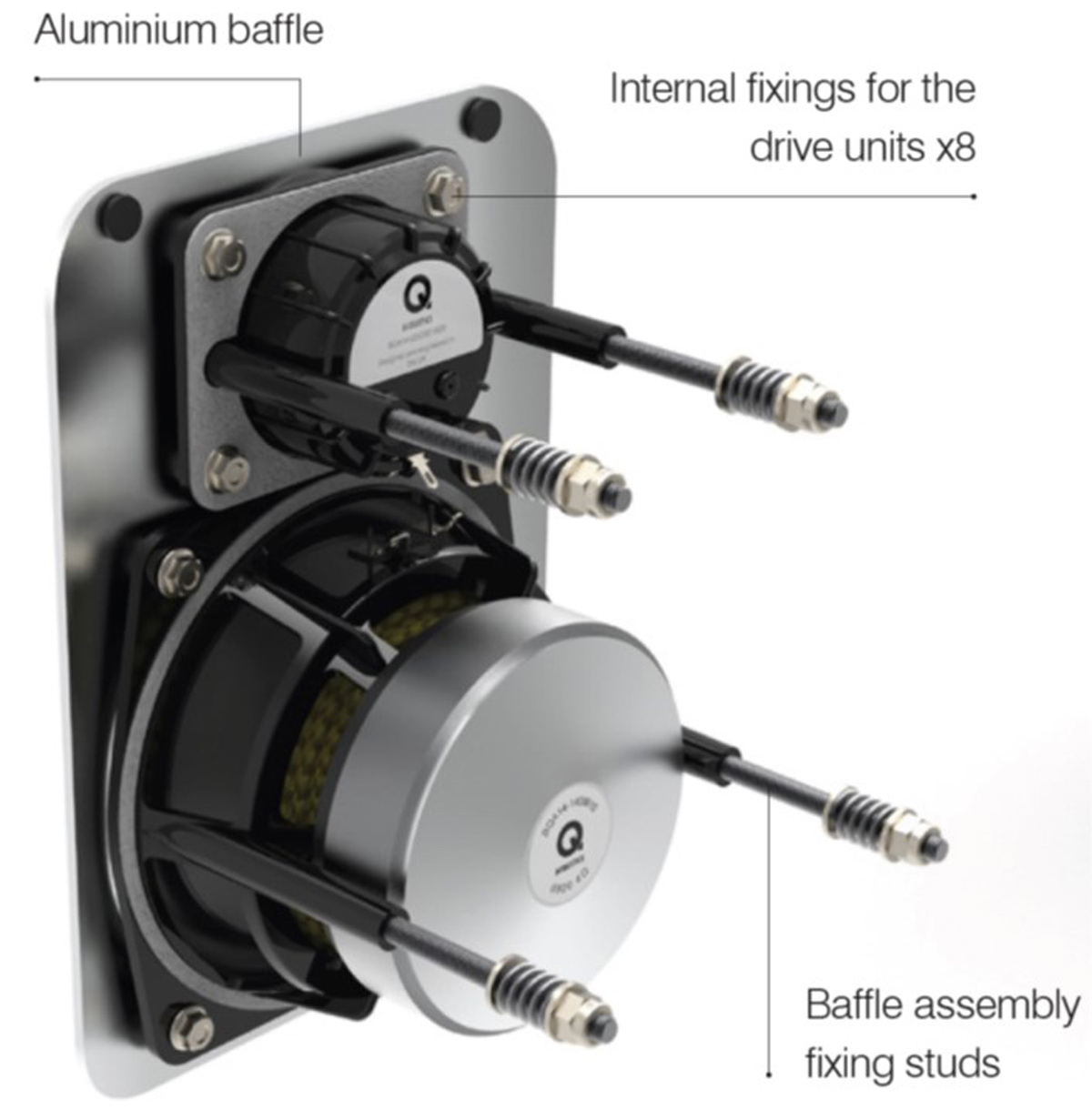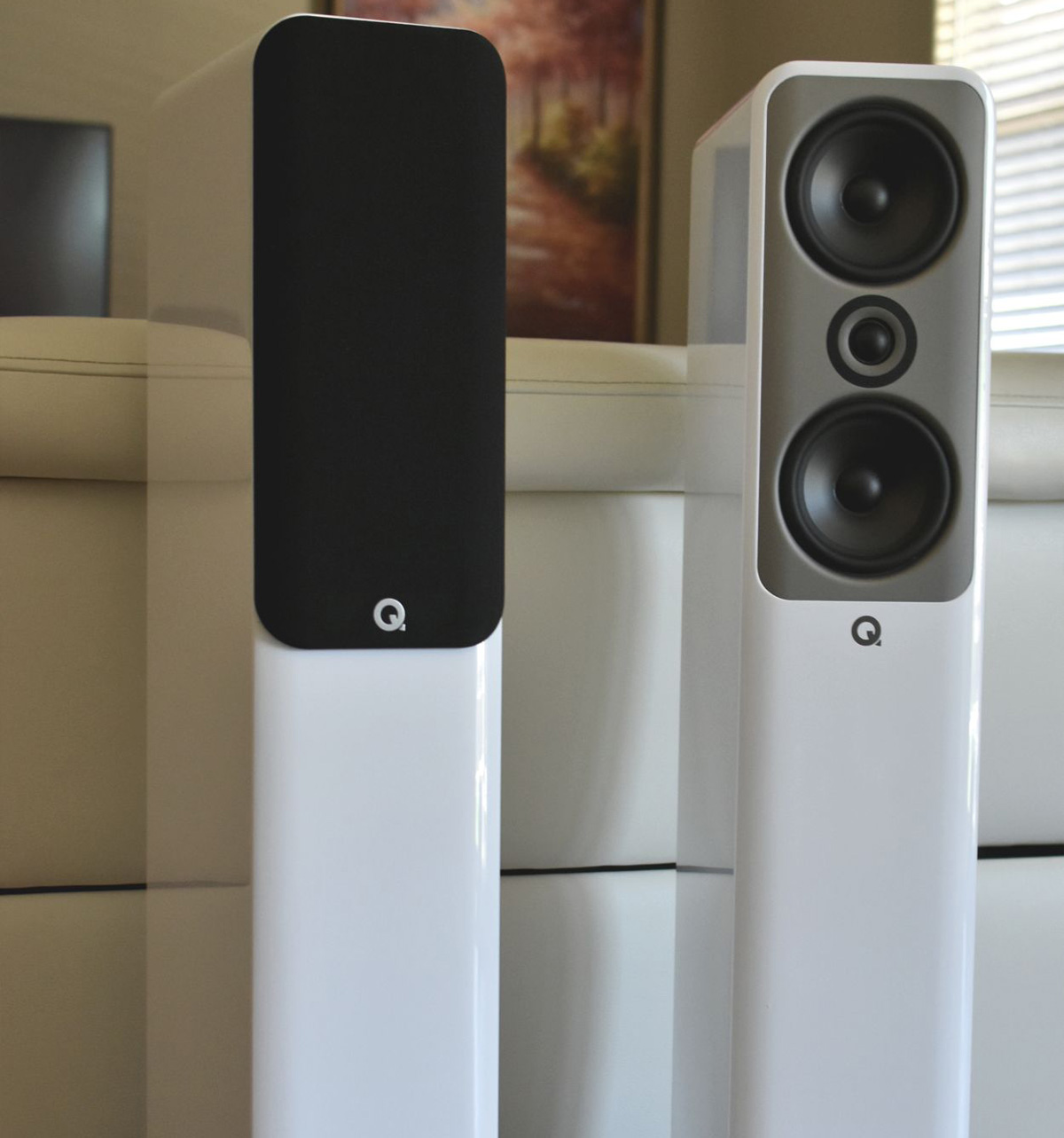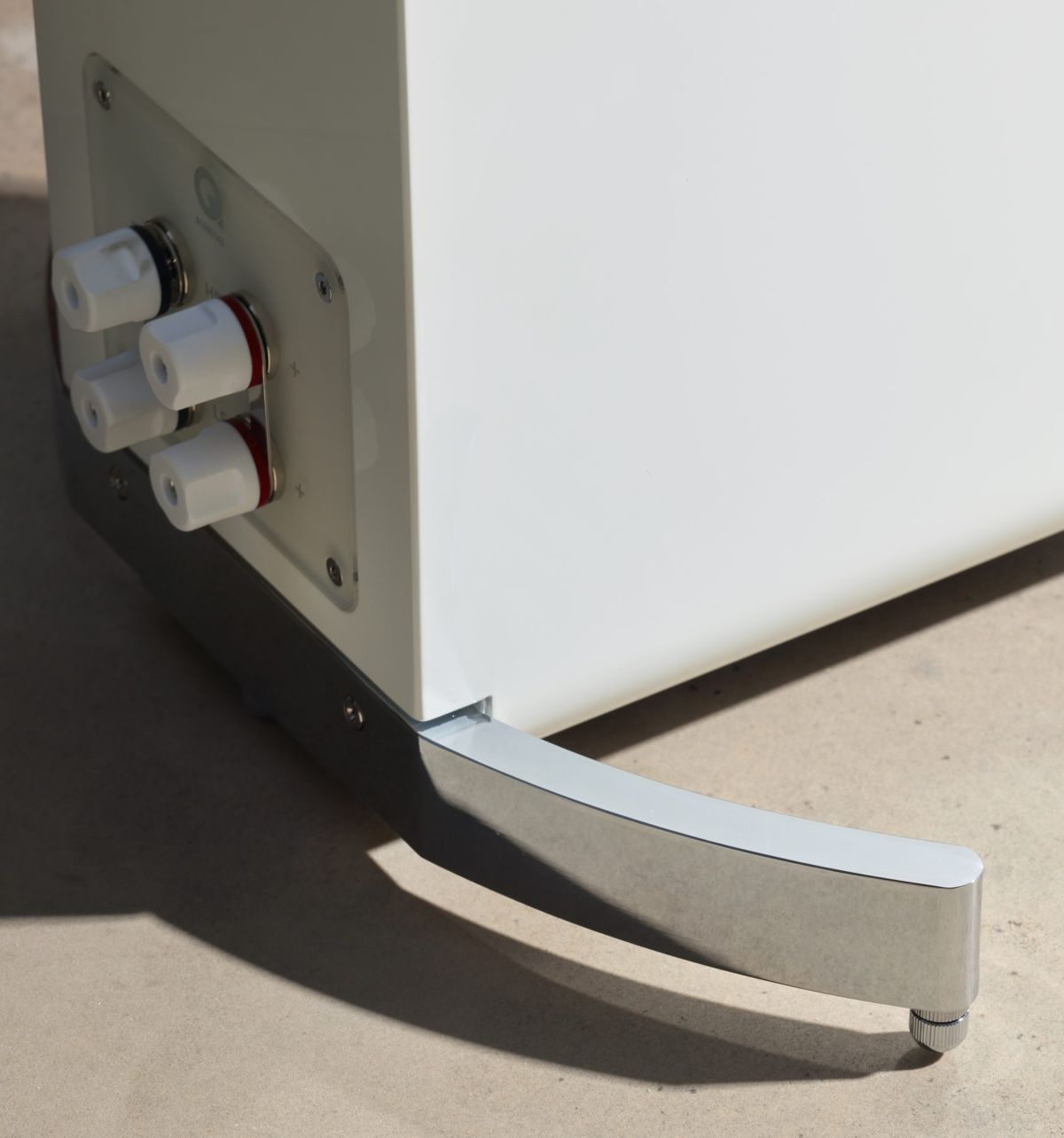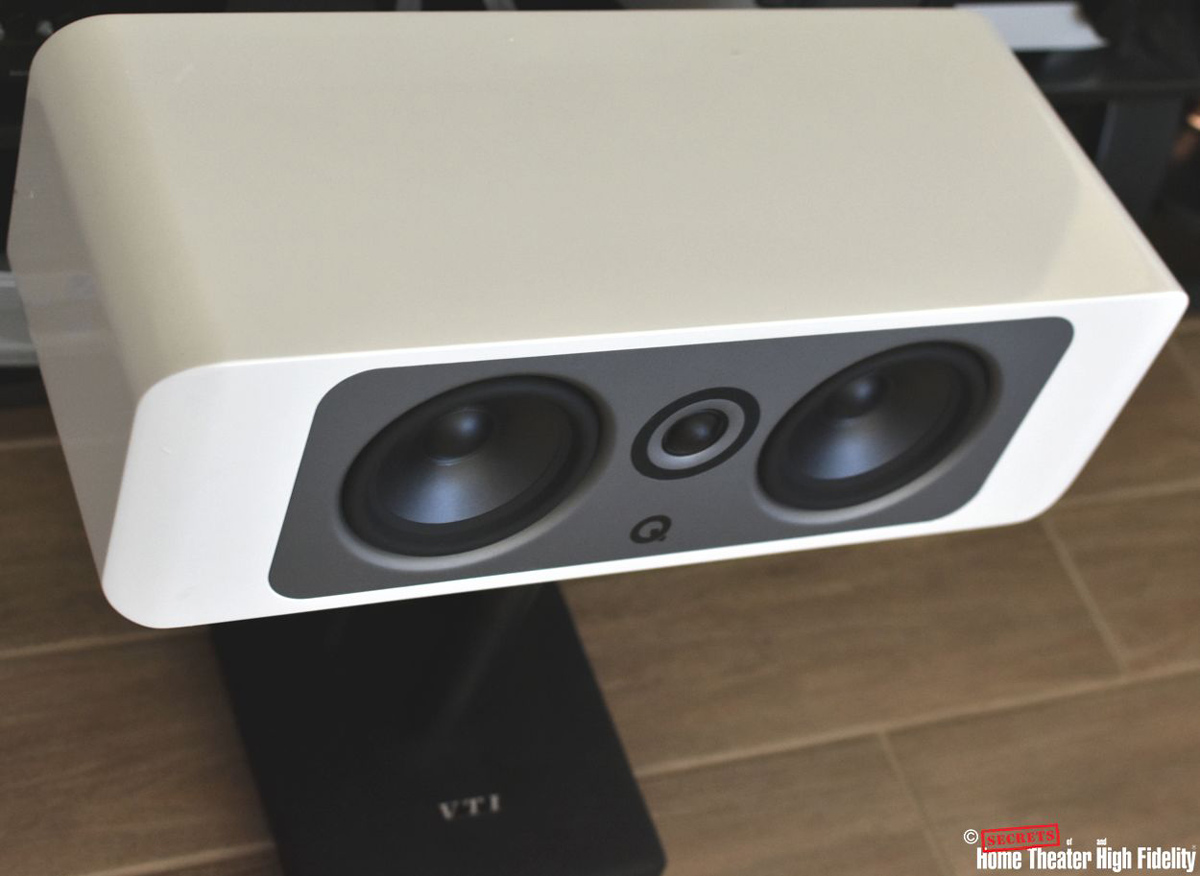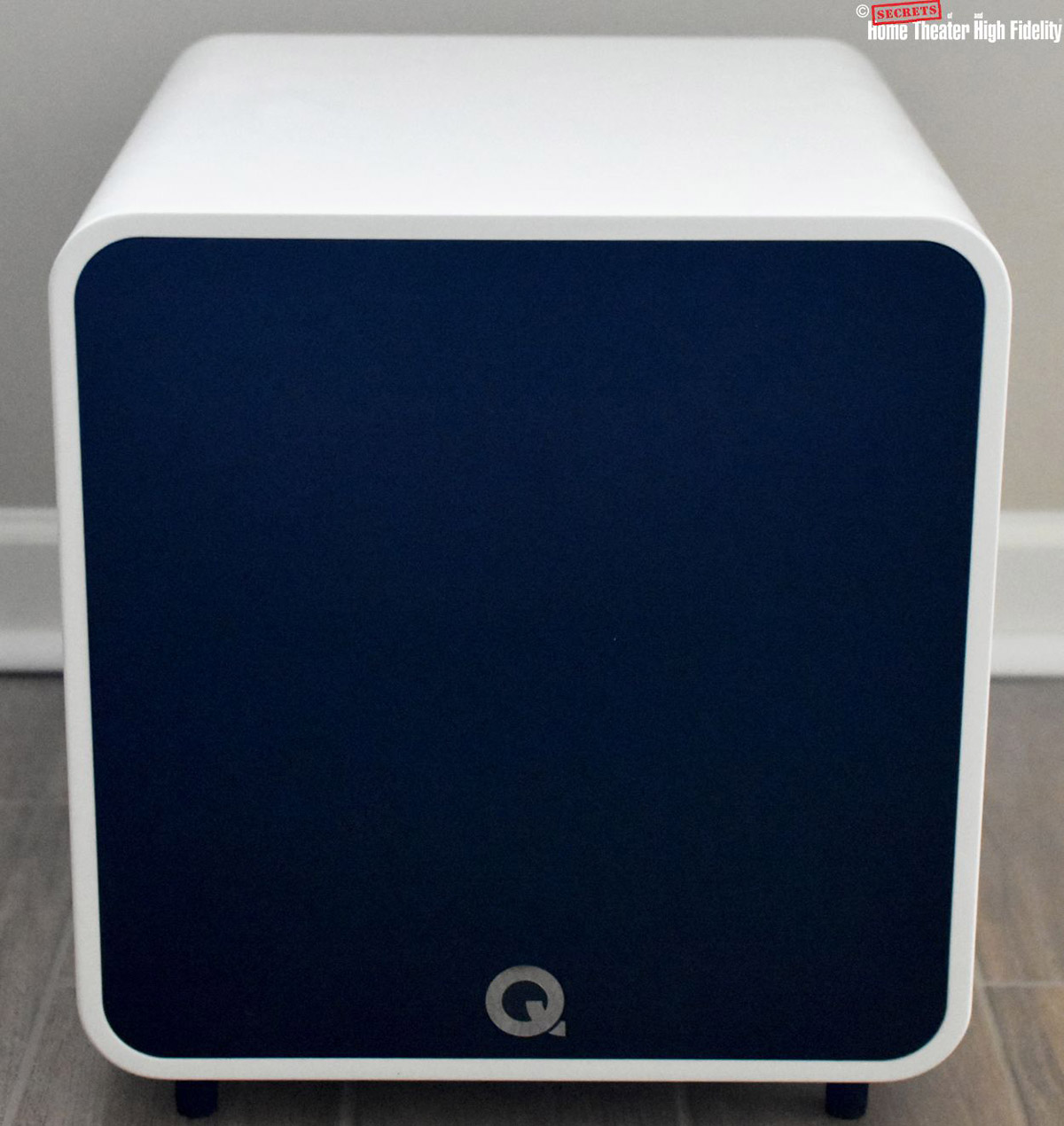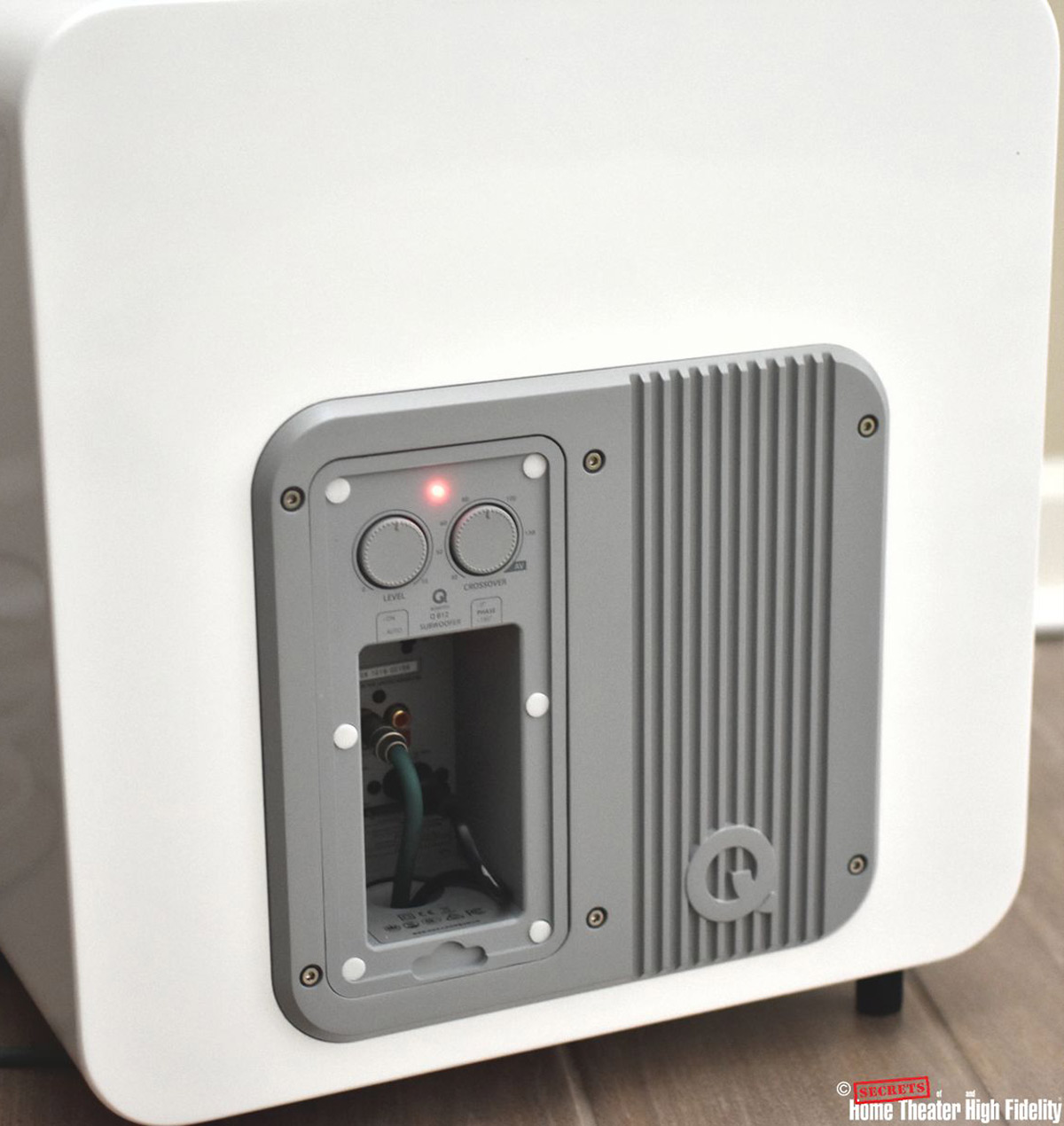Alongside the new implementation of acoustic innovations, the new Q Acoustics’ Concept series speakers, consisting of the Concept 50 floor-standing, Concept 30 bookshelf, and Concept 90 center channel, are equipped with some trickling down cutting-edge technology and design from the pioneering flagship models, the Concept 300 and 500. Most of the innovations and design choices applied to the Q Acoustics speakers are geared toward minimizing cabinet resonances, aiming to reduce sonic artifacts and artificial sound coloration. The commitment to apply this “silencing the cabinet” philosophy throughout the company’s range of speakers in a way makes Q Acoustics unique in its approach to speaker design.
Q Acoustics Concept 50 Home Theater System
- Innovative implementations of cabinet-resonance minimization techniques.
- Modern chic-looking speakers with great build quality and finish.
- Excellent performer in stereo and surround applications.
Founded in 2006 in the United Kingdom, Q Acoustics is a relatively young audio company. With its unique approach to the speaker design, based on the idea that the minimization of the cabinet resonances leads to purer and less colored sonic reproduction, Q Acoustics has garnered many accolades for its products. These many achievements firmly establish the company’s existence and reputation in the audio world.
The Concept 50 Home Theater System reviewed here is a 5.1 speaker system consisting of 5 speakers from the new Concept series models (a pair of Concept 50 floor-standing speakers, a Concept 90 center channel speaker, a pair of Concept 30 bookshelf speakers), and a Q B12 subwoofer. The MSRP of this speaker package is $6,295, which puts it in the medium price range category. For this review, Q Acoustics also included the Q FS75 optional stands (MSRP $499 /pair) for the Concept 30 speakers. With their rounded cabinet edges and glossy finish, the speakers sport a modern chic look that is simple yet stylish. The review samples came in glossy white, but glossy black and glossy silver finish options are also available.
Concept 50 floor-standing speaker
Mid/Bass drivers:
2 x 5.0 in
Tweeter:
1 x 0.9 in
Frequency response(-6dB):
42 Hz – 30 kHz
Nominal impedance:
6 Ω
Minimum impedance:
3.6 Ω
Sensitivity (2.83V @ 1kHz):
90.5 dB/W/m
Crossover frequency:
2.1 kHz
Distortion (120Hz – 20kHz, @2.83Vrms):
<0.2%
Dimensions (per loudspeaker / H x W x D):
40.4 x 16.5 x 12.6 in (including spikes and stabilizer), cabinet width: 7.1 in
Weight (per loudspeaker):
50.5 lbs.
Concept 30 stand-mount speaker
Mid/Bass driver:
1 x 5.0 in
Tweeter:
1 x 0.9 in
Frequency response(-6dB):
54 Hz – 30 kHz
Nominal impedance:
6 Ω
Minimum impedance:
3.9 Ω
Sensitivity (2.83V @ 1kHz):
87 dB/w/m
Crossover frequency:
2.4 kHz
Distortion (120Hz – 20kHz, @2.83Vrms):
<0.2%
Dimensions (per loudspeaker / H x W x D):
11.2 x 7.1 x 12.6 in
Weight (per loudspeaker):
17.4 lbs.
Concept 90 center
Mid/Bass drivers:
2 x 5.0 in
Tweeter:
1 x 0.9 in
Frequency response(-6dB):
67 Hz – 30 kHz
Nominal impedance:
6 Ω
Minimum impedance:
3.7 Ω
Sensitivity (2.83V @ 1kHz):
90 dB/w/m
Crossover frequency:
2.1 kHz
Distortion (120Hz – 20kHz, @2.83Vrms):
<0.2%
Dimensions (per loudspeaker / H x W x D):
7.2 x 21.7 x 10.2 in
Weight (per loudspeaker):
27.1 lbs.
Q B12 subwoofer
Driver:
12in high-excursion and stiffness straight-sided paper cone
Peak amplifier power:
440 W
Continuous amplifier power:
220 W
Power type:
Class D
Frequency range:
28 Hz – 300 Hz
Crossover frequency range:
40Hz – 250Hz
Enclosure type:
Infinite baffle
Dimensions (H x W x D):
15.7 x 15.7 x 17.6 in
Weight:
47.40 lbs.
Concept 50 Home Theater System MSRP:
$6295
Optional Q FS75 stands for Concept 30:
$499/pair
Website:
Company:
SECRETS Tags:
q acoustics, concept 50, home theater system, home theater system review 2022
The Concept 50, 30, and 90 speakers utilize a two-way crossover design in bass-reflex cabinets. Both the 5-inch mid/bass and 0.9-inch tweeter drivers used in these speakers are new and designed as an integral part of the mechanical structure of the cabinets. The mid/bass driver uses coated paper cone and low-hysteresis rubber surround. Its voice coil is made of glass fiber and has a relatively large diameter of 30.5 mm for increased power handling and reduced dynamic compression. The tweeter is of a dome variety made from coated microfiber. It is hermetically sealed and mechanically isolated from the baffle for lower distortion. All these drive units are mounted to a stiff 3-mm aluminum baffle plate before being fitted to the cabinet to dampen the vibrations and minimize the structural coupling.
The Concept 50 floor-standing speaker uses three aligned drivers, where the tweeter is flanked by the two mid/bass drivers. The same number of drivers are used in the Concept 90 center channel; however, the tweeter is positioned slightly above the line connecting the center points of the mid/bass drivers in the horizontal orientation. The smaller Concept 30 speaker only uses a tweeter and a mid/bass driver. All these speakers have their ports on the back. Plugs for these ports are provided, which can be useful to tweak the bass response of the speakers when the situation calls for it. All the speakers in the Concept 50 Home Theater System are equipped with high-quality bi-wire terminals made from nickel-plated solid copper. By default, these terminals are connected by metal jumpers for a single-wire connection. These speakers are overall very well constructed.
The crossover of the speakers is a modified second-order design and uses high-grade film capacitors, air-core inductors, and high-power wire-wound resistors. The crossover board is mounted on the isolated base of the speaker, which is used to eradicate unwanted external and internal residual vibrations. The isolated base is a dual plate design where the upper plate, made of synthetic resin bonded glass fiber, fixes to the base of the speaker, and the lower plate, made of zinc-plated steel over-molded in silicone, couples to the floor. The two plates are spaced by a suspension system, which is formed by fourteen independent molded spheres. Even though all the speakers in this Concept 50 Home Theater System use the same tweeters and mid/bass drivers in a two-way configuration, their crossover points differ slightly. The Concept 50 and 90 speakers have their crossover frequency at 2.1 kHz, while the smaller Concept 30 speaker has its crossover frequency at 2.4 kHz. There was no obvious dip/peak in the frequency response measurements of the speakers around their crossover frequencies, indicating an excellent crossover tuning job.
Secrets Sponsor
Besides the drive unit and crossover innovations above, these new Concept series speakers are equipped with the following in-house developed resonance minimization features:
- GelcoreTM cabinet wall, which is constructed from two layers of MDF separated by non-setting adhesive gel to reduce the high-frequency cabinet noise.
- Point-2-Point™ (P2P) bracing, which is to stiffen specific areas of the cabinet to minimize lower frequency vibrations (not applied on the Concept 90).
- Helmholtz Pressure Equalizer (HPE™) tube technology, which converts pressure to velocity to reduce the standing waves and overall pressure gradient within a tall speaker enclosure (used in the Concept 50).
You can tell that Q Acoustics goes above and beyond most other speaker manufacturers in taking care of the cabinet resonances. Apparently, the effort does not stop there, and it extends to the use of specifically designed Tensegrity-inspired Q FS75 stands for the Concept 30 and the special isolation base support for Concept 50. Although the Concept 30 speakers can be used with third-party stands, the Q FS75 stands, which are attached using screws to the isolation suspension panel on the base of the speakers, are designed to minimize vibrations going up the stand and down from the speaker when compared to a traditional speaker stand design, reducing further the potential coupled body-stand vibration noise. On the Concept 50, the isolation base support allows for a certain amount of movement within the speaker base that is intended to further decouple the speaker body from the base support. Metal screwable spikes and rounded feet are also provided with the base support, to be used based on the type of floor the speaker will be placed upon.
The Concept 90 is a medium-size center-channel speaker, which can be easily placed on a shelf or table as it does not take up too much space. This center-channel speaker does not come with an inclination adjustment feature, so nominally it lies flat on the surface it is placed on. You can, for example, incline the speaker by attaching a set of different height front and rear rubber feet, but doing so bypasses the function of the isolation base. For this review, I put it on an inclined center channel stand and place it below but slightly in front of my television.
As there is no specific surround speaker in the Q Acoustics product lineup, the Concept 30 bookshelf speakers hold the surround duty in this Home Theater System. For those of you who prefer to wall-mount the surround speakers way above the ear level, Q Acoustics makes a specific wall bracket for the Concept 30 speakers, called WB75 ($89 each). These brackets can also support the Concept 90 speaker. If the room can accommodate ear-level surround speaker placement, you can also mount the Concept 30 speakers on the stands, like what I did in this review (using the Q FS75 stands).
The subwoofer included in the Concept 50 Home Theater System is the Q B12, which features a 12-inch driver in a sealed-box design powered by a 220 W class D amplifier. With its rounded edges, the squarish cabinet of the Q B12 possesses a similar style to the rest of the speakers in the package. The Q B12 in the review package has the same glossy white finish and black cloth grille as the other speakers. The Q Acoustics website indicates that the subwoofer also comes in glossy black or non-glossy finishes (arctic white and carbon black). The grille of the subwoofer is not removable. Four screw-in spike feet are provided to lift the subwoofer above the floor. Rubbers to cover the spikes are also included for application on the hard-surfaced floor. This subwoofer has a typical weight for a subwoofer of its size and is not terribly large for a 12-incher, hence I found that moving it around during the setup process was not too difficult.
The controls and connectors as well as its plate amplifier are located on the back, attached to the light gray metal panel. Except for the level and crossover rotary knobs, the other controls, and connectors of the subwoofer, which include an auto-on switch, 0/180-deg phase switch, line-level input connectors, AC power input, and the main power switch, are located on the recessed part of the panel. Should you desire to cover this recessed panel area, a magnetically attached fitted metal plate is provided. When covered, it hides the cables connecting to the subwoofer, which can be routed to this recessed panel area through a hole opening on the bottom part of the cabinet. I like this design touch, as it removes the cluttered look of the cable connections behind the subwoofer.
As most speaker systems will likely find multi-purpose use, besides evaluating how well the Concept 50 speaker system performed in a home-theater application, I also evaluated its performance in a two-channel stereo music application. During the review, the front two channels, which were usually occupied by the Concept 50 floor-standing speakers, were driven by the Michi X3 integrated amplifier (200 W per channel into 8 ohms) or the combination of the Classe CP-700 preamplifier with the Bel Canto Ref500S amplifier (250 W per channel into 8 ohms). The center channel and surround speakers were driven by the Bel Canto eVo6 gen-II amplifier (6 channels, 120 W per channel into 8 ohms). The Marantz AV8802 handled the surround processing duty through the Home-Theater Bypass function of the Michi X3 or the Classe CP-700. The Qobuz streaming service was used as the music source through the Auralic Aries G1 streamer and various video streaming services, such as Netflix and Paramount+, were used for the movie sources.
In their final positions which I deemed to yield the best results in my room, the Concept 50 speakers were about 8 ft apart from each other and about 9 ft away from the main listening position. The speakers were slightly toed-in for good imaging during the stereo music listening. I found that in my room, pulling the speakers into the room such that their front baffles were about 4 ft away from the wall behind them resulted in the best bass response balance. The Concept 90 center channel was placed on the stand right in the middle between the Concept 50 pair. The stand has a slight inclination directing the front speaker baffle roughly towards the listener’s ear level. The Concept 30 speakers were put on the FS75 stands close to the side walls and slightly behind the listening position at about 6-7 ft away from the center seating position. After moving it around a bit, the final location of the Q B12 subwoofer for a satisfactory bass response at the listening positions was near the front right corner of the room. The Audyssey MultEQ® XT32 on the Marantz AV8802 was used to calibrate the speakers and the subwoofer for the surround setup.
I mentioned earlier that Q Acoustics applied various innovative approaches to minimize the cabinet resonances in the speakers it designed. While I had no means of measuring directly what Q Acoustics achieved in this endeavor, I could confirm that when listening to this Q Acoustics speaker package, I was presented with clear sonic characteristics that hinted at the non-existence or minimum artifacts from the possible cabinet resonance interference. Clear, smooth, and balanced sounding were the immediate attributes that came to mind when I first listened to these speakers. Besides seemingly free from artifacts, the speakers also sounded smooth and free from uncalled for rough sonic edges. With all these clear and smooth sonic characteristics, the speakers did a great job overall in maintaining the sonic textures in the program materials that added excitement and realism to the overall presentation. A quick nearfield on-axis measurement confirmed the balanced sounding character of the speakers. Overall, the measurement results indicate well-balanced and excellent flatness in the frequency responses across the bass, midrange, and treble regions.

Concept 50 nearfield on-axis frequency response

Concept 30 nearfield on-axis frequency response

Concept 90 nearfield on-axis frequency response
Naturally, I listened to the music in stereo on the front-channel speakers, which were the Concept 50 floor-standing speakers. But occasionally, I moved the Concept 30 speakers from the surround positions to the front in place of the Concept 50 to assess how they did in the stereo application. Not surprisingly, the Concept 30 speakers performed comparably well to the Concept 50 in such an application. Both the Concept 50 and Concept 30 demonstrated similar sonic attributes and characteristics. The difference was mainly in the capability of the Concept 50 to reach lower into the bass region. Augmenting the Concept 30 with a good subwoofer or two would definitely overcome their bass-response limitation and could potentially achieve similar or better results than just the Concept 50 alone.
In stereo music application, the three strong attributes mentioned previously were really obvious in the presentation of the Concept 50 speakers. Overall, the speakers sounded neutral with a touch of warmth and always presented music in full body. The smoothness and the touch of warmth of the speakers’ sonic characteristics prevented listening fatigue and made them suitable for long-duration listening. The speakers presented details and transient attacks in the music extremely well, although I noticed a bit of politeness in their top-end presentation.
These were not glaring by any means, and only noticeable in comparison to other speakers for certain types of music. The sound of the cymbals in the track Left Alone from the late Jimmy Heath’s Love Letter (2020) album, for example, sounded a bit rolled-off at the very top end compared to the presentation from my Revel Ultima Studio speakers. Not by much, but nevertheless, the difference in the top-end energy and treble extension was there. The Concept 50 speakers in general did a very good job in reproducing vocals. Cecile McLorin Salvant’s voice in the same track sounded natural and full body. Her breathing in the song, which was captured in the recording, sounded lifelike and added presence to the overall presentation. The image produced by the speakers was steady with sufficient focus. The soundstage’s width and depth portrayals were respectable.
The Concept 50 is not a large floor-standing speaker by any means, but surprisingly it packs a good and articulate bass response. While being impressed by the natural vocals and the musical texture conveyance of the track Lost Vegas by Youn Sun Nah from her latest album Waking World (2022), I couldn’t but notice the strong bass response produced by the Concept 50 speakers. The bass content in this track sounded articulate with good attack and sufficient authority. Although the bass response of the Concept 50 by themselves was good and sufficient for most program material, adding the Q B12 subwoofer in the stereo application proved to enhance the result further, especially improving the lower bass extension of the musical presentation, which could make a significant difference for bass-heavy musical materials.
The track Oblivion by the Mexican acoustic guitar duo Rodrigo y Gabriela from the album Jazz EP (2021) sounded especially terrific through the Concept 50 speakers. The guitars sounded realistic, and the attacks were portrayed with the right rhythm and transients, which led to the conveyance of the full emotion of the music. This track also demonstrated the impressive ability of the Concept 50 speakers to extract the spatial separation between the two guitars from the tightly interwoven melody coming from the fast-paced plucking and strumming of the two sets of the guitar strings.
You can tell from my comments above that the Concept 50 speakers (and also the Concept 30 for that matter) are strong performers in the stereo music application. I am also glad to report that in surround applications, the Concept 50 Home Theater System also showed considerable prowess. The timbre match across the speakers was excellent, hence no sonic character changes observed when the sound panned from one speaker to another. This system is not only capable of delivering smooth enveloping surround performance, but also conveying the necessary impacts when called for.
The ability of the Concept 90 center channel speaker to deliver solid center sound effects with excellent clarity served as a formidable anchor to this surround speaker system. This medium-sized center channel never sounded thin and could play loud without strain. It might not have the last word in depth portrayal; however, it was quite adept in that regard. I found that the horizontal and vertical dispersion characteristics of the Concept 90 center channel were sufficient to handle typical small-to-medium-sized home theater setups. Shifting left or right up to four feet away from the center seating position did not cause any noticeable change in the resulting sonic clarity.
Secrets Sponsor
The Concept 30 speakers are more than capable of handling the surround duty. As mentioned previously, these speakers by themselves were quite adept for stereo application. As it turned out, they were no slouch in operating as the surround speakers either. That the speakers could deliver excellent surround localization was to be expected, but I found out that they were at home too in delivering diffuse sonic envelopment. During the time of this writing, the 2022 NBA playoffs were ongoing, and watching these games in surround sound through the Concept 50 Home Theater System really elevated the enjoyment. The Concept 30 speakers delivered the hall echo and the enveloping crowd noises convincingly leading to a realistic portrayal of the sport-hall atmosphere.
The addition of the Q B12 subwoofer in the system definitely made a difference in the bass department and the overall home-theater experience. The nearfield frequency-response measurement that I took revealed that the subwoofer was true to its specifications of 28-300Hz (+/- 3dB). Obviously, this is not a subsonic bass-producing subwoofer, but after living with it for a while, I could vouch for its ability to pressurize even my rather large room and it had no problem in generating quick and punchy bass at a sufficiently high level. Moreover, with its relatively high-frequency reach (300 Hz), this subwoofer should also be suitable to complement small satellite speakers that have a limited low-frequency extension.
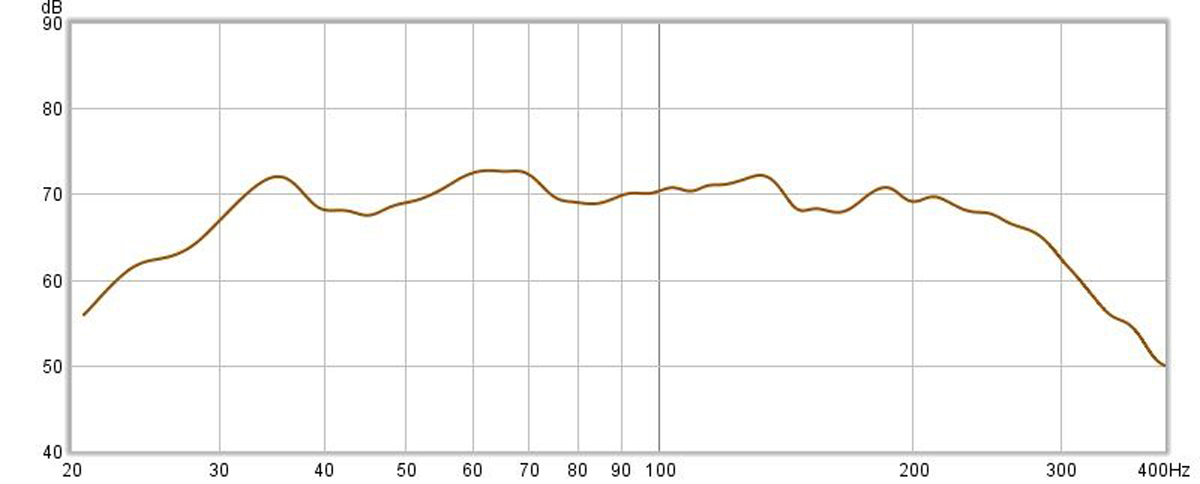
Q B12 subwoofer nearfield frequency response
I had a chance to watch Jason Statham’s Wrath of Man (2021) action movie through the Concept 50 Home Theater System and I would say the experience was very enjoyable. The movie itself had a typical Jason Statham cinematic action flavor (which I like) and through this Q Acoustics system, the dialogue in the movie sounded intelligible and the sound effects along the action on the screen sounded lively with enough impact and weight. The string and percussion music appearing in the background of various parts of the movie were delivered in such finesse, elevating the overall watching experience.
The Protégé (2021) was another slick action movie that I watched through the Concept 50 Home Theater System. I thought this movie really showcased the prowess of the surround performance of the Concept 50 speaker system. It specifically highlighted the ability of the Q B12 subwoofer to generate the impactful actions in the movie, which would otherwise lack without its presence. The bass rhythms underlying many of the scenes in the movie were conveyed articulately by the subwoofer. The Q B12 also gave each flying bullet in the movie an extra zing which added excitement to the overall cinematic experience.
The CONCEPT 50 HOME THEATER SYSTEM showcases Q Acoustics’ achievement in delivering a good value multi-purpose home audio speaker system through the implementation of no-nonsense design innovations.
- Stylish-looking speakers with great build quality and finish
- Quality components and no-nonsense innovative features
- Excellently timbre-matched surround speaker package
- Well-balanced and smooth sounding speakers
- Strong stereo and surround performances
- Nothing of note.
In the Concept 50 Home Theater System, Q Acoustics has created a versatile multi-purpose 5.1 speaker package that looks and sounds great. This modern chic-looking speaker system is well built and definitely easy on the eyes. Moreover, equipped with the Q Acoustics’ design innovations paying special attention to minimizing the effects of the cabinet resonances, the Concept 50 Home Theater System delivers well-balanced strong all-around sonic performance in home-theater and stereo music applications. This system brings a good value to the table with its unmistakably high performance-to-cost ratio, and I can easily recommend it to someone looking for a high-performance medium-size home theater speaker package.


